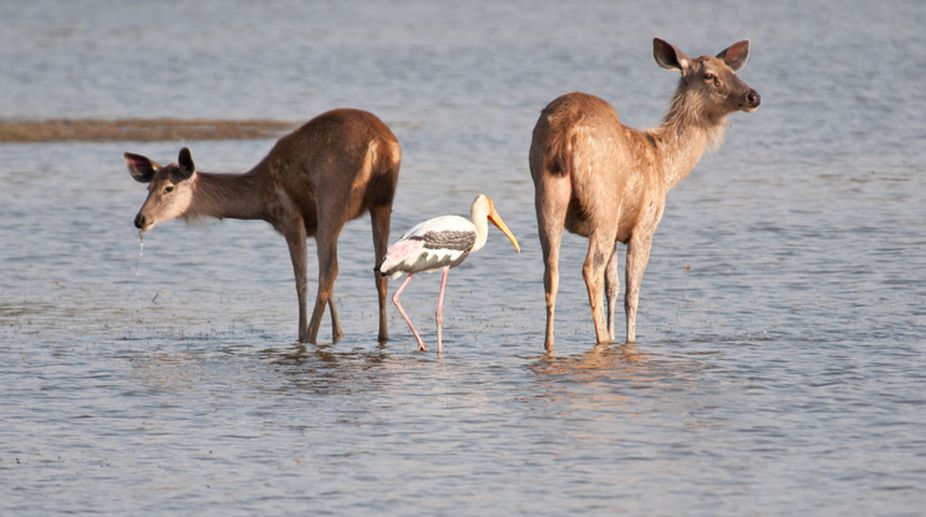Stakeholders discuss ways to up production at poultry fair
West Bengal ranks first in meat production in the country and contributes to 12.62 per cent of the country’s total meat production.
This man had long been a strict vegetarian, but had suddenly taken to meat-eating late in middle-age, and developed a passion for venison.

(Getty Images)
There used to be a story told about a certain conservator of Forests, that whenever he visited a sanctuary in his domain, wild dogs would kill a sambar or a chital.
This man had long been a strict vegetarian, but had suddenly taken to meat-eating late in middle-age, and developed a passion for venison. He was a notoriously hard taskmaster, and quite uninhibited in his manners. Having to maintain his position in the eyes of his subordinates, he would look disapprovingly at the large plate of venison before him, and sternly demand how they had come by it in a sanctuary, and they would tell him in circumstantial detail how the heartless wild dogs had torn down this tender fawn and how, attempting to rescue the victim, they had only succeeded in recovering its carcass.
Advertisement
Perhaps this story was largely an invention, for that Conservator was little loved, but the sad truth is that in many of our sanctuaries, with the ignorance of those in actual charge of the area and the bureaucratic limitation to rules and regulations of their bosses, such a story could well be true. The Forest Codes of our States, enacted long ago when conditions and values in life were very different, seem to favour the view that predatory animals seek their meat not from God, but from the Government. A kill, chanced upon in the forest and removed, has to be auctioned by the rules, for it is perishable and anything perishable has to be auctioned before it can deteriorate and lose value.
Foliage for green manure, illicitly collected in the Reserved Forest and abandoned by the poacher while fleeing from departmental officials, has to be auctioned at once, before it can become worthless by drying up. Logically, a kill would go by the same rule.
Advertisement
My law is somewhat rusty, but I believe that the provisions of a code would still hold against departmental injunctions which do not have the authority of an enactment; may be the latter are more often honoured in practice, but that is something that need not be considered here. The question is, in how many of our States where the prompt disposal by auction of perishables found in the forest is enjoined by a code or act, has the provision been suspended in sanctuary areas also by enactment? In none, so far as I know.
My picture shows a chital hind killed by a leopard in a sanctuary. I came upon the kill accidentally while traversing a thick jungle, and left at once, after taking a hasty snapshot of the dead hind without disturbing it in any way, so as to give the leopard every opportunity to return to its legitimate meat if it was lurking in the neighbourhood, as seemed likely. Even if the killer had not done so, the carcass should have been left to the undertakers of the forest, to the hyenas and lesser carrion freeders. But, in fact, this carcass was removed and auctioned by the officials of the area.
This is only one of many instances I can mention from personal knowledge of a natural kill in a sanctuary being appropriated by humanity. Apparently people do not realise that they are doing something very wrong by removing a kill in a sanctuary. Apart from the fact that the predators are as much entitled to protection in such a place as their prey, their vital role in the maintenance of the balance of nature is not appreciated-in the absence of predators, the herbivores, with no check on their numbers, are likely to develop into a real menace.
I will not go further into this patent truth, but may briefly point out that the notion that some predators are “cruel” and “bloodthirsty” and a menace to the herbivores, and should, therefore, be killed or discouraged, is entirely fallacious. Wild dogs may be taken as an example, for quite a number of men who should have known better have allowed sentiment to blind them to the truth in writing about them, and till recently there was a reward offered for the killing of wild dogs in the mistaken belief that they cause “irreparable” damage to deer—it could be that the reward is still being offered in places.
It is true that the wild dog which is about a tenth the size and weight of the adult sambar it may hunt, kills not in one quick pounce but by tearing out the flesh of its victim piecemeal. To us this may seem a singularly cruel method, and not clean killing, but it cannot kill large quarry any other way, and most often the victim dies quickly enough. The idea that wild dogs lead to the decrease of the deer is probably wrong; for thousands of years wild dogs and deer have coexisted here, long, long before any price was set on a dhole’s brush or mask, and but for wild dogs many deer (chital in particular) would not only have eaten down the vegetation in places, but would also have probably degenerated bodily. So long as our wildlife effort is governed by a sentimental anthropomorphism, and antiquated, handicapping codes and acts, there is little hope for the animals in our sanctuaries.
Advertisement